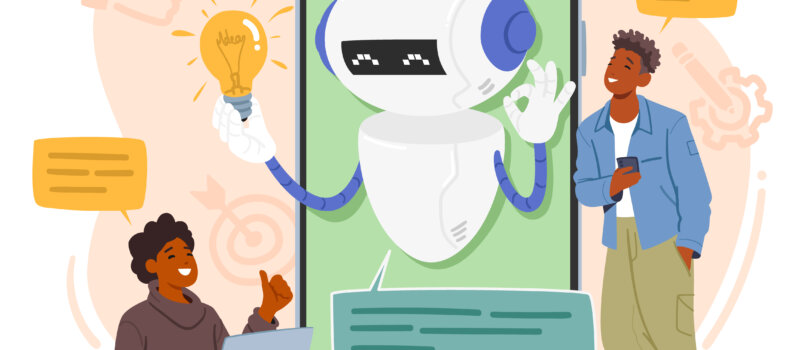As artificial intelligence becomes more powerful and conversational, the number of people who “hate talking to a machine” is gradually shrinking. In fact, 73% of consumers expect websites to utilize some type of application of AI chatbot programs as a self-service option.
Are you already using chatbots and looking for additional ways they can drive value to your organization? On the other hand, are you new to these tools and need ideas for where to start?
Check out practical ways to use AI chatbot applications to enhance customer service and employee efficiency.

Key Takeaways:
- Carefully choose when to deploy proactive chatbots that appear without prompting and reactive ones that respond to user queries or actions.
- Top use cases for chatbots include customer support, reservations, surveys, and lead qualification.
- AI chatbots can also be virtual assistants that boost worker productivity.
A Proactive vs. Reactive Approach to Your Application of AI Chatbot Software
When deploying any application of AI chatbot software, determine whether the program will be proactive or reactive.
The Difference Between Proactive and Reactive
Proactive bots engage a user without any prompting. They pop up and ask to help or perhaps share a reminder.
In contrast, reactive chatbots respond to a trigger by the user. In this case, the person specifically asks for something from your team. Before connecting the individual with a human agent, the chatbot tries to resolve the situation.
How To Decide Which To Use
Just as you don’t want to be too pushy or “salesy” in person, don’t have proactive chatbots pop up so much that they interfere with a smooth website experience. Situate proactive chatbots only in locations where they are likely to be necessary or welcome by the user.
For example, an application of your AI chatbot could pop up almost immediately on your home page. It could ask users to share what they’re looking for and send them to the right locations on your site.
On a blog post, the user’s initial intent is usually to read that information, and a chatbot at the start of the page could be annoying. Instead, you could put a proactive chatbot at the end once the individual has finished reading. There it can serve as a call to action that increases conversions.
Reactive chatbots are almost always appropriate as a first response to requests. If the user would rather engage with a human, the person can specifically ask that of the system.
8 Top AI Chatbot Application Use Cases
You’re bound to discover multiple uses for AI chatbots, but these are an excellent place to start.
1. Customer Support
Customer support is almost always the first application of an AI chatbot you should create. The primary reason is to ensure customers feel like someone is attending to them promptly whenever a challenge arises.
The chatbot can start by answering questions or directing users to a video or post that solves the problem. If the matter is complex, it can forward them to an appropriate agent or create a support ticket for a prompt callback.
Chatbots can also permit basic account management in a secure environment. Natural language processing makes it easier than ever for customers to handle tasks such as payments and transfers with conversational inputs.
2. Personalized Discounts and Offers
A person could be browsing your site and that of your competitors looking for the best deal. If the individual is a returning customer, the chatbot can compare browsing and purchase history alongside other interactions to see if the user qualifies for a discount.
This type of offer can be more effective than predictable time-limited promotions or coupons that pop up when users click away.
3. Lead Qualification and Surveys
Large purchases typically have a longer sales cycle and require more interactions with a prospect. In the early stages of the buyer funnel, users may respond to questions from an application of an AI chatbot more readily than an email or a phone call. Use the tool to capture more conversions.
A chatbot can also help you learn more about what your customers are thinking with a quick poll or survey. The data will improve your marketing and sales tactics.
4. Product Suggestions
If a customer keeps searching your site for similar items without buying, the chatbot could make product suggestions. This can be a more personalized and helpful message than an abandoned cart notification.
5. Reservations
As easy as you make your web page to navigate, someone might still struggle to toggle all of the right filters when making a reservation. An application of an AI chatbot can be the perfect virtual assistant to walk users through the process.
6. Private and Confidential Discussions
Some customers may not want to discuss sensitive information with a human agent. Your AI chatbot can answer questions and provide account details, all while complying with strict privacy and data collection rules.
7. Notifications, Updates, and Reminders
Relevant news updates can be a way to add value to discerning buyers, especially in the B2B market. If you’re in an industry where breaking bulletins are valuable to clients, such as finance, consider a proactive chatbot that shares pertinent information.
8. Hiring, Training, and Work Tasks
Chatbots are not just for customer service. They can be helpful tools for your employees as well. For instance, chatbots can assist human resources by interacting with and qualifying prospective hires.
Likewise, your employees can use an AI assistant to help with repetitive tasks by answering questions, translating information, summarizing text, and handling numerous other assignments.

Use Your Favorite Application of an AI Chatbot in a World-Class Contact Center
Whichever application of an AI chatbot you decide on, it has to be part of a robust contact center solution. For a cloud-based service that lets you offer smarter customer engagement, talk to us at Intermedia about our world-class software.
May 15, 2024
Explore other posts on these topics: AI




